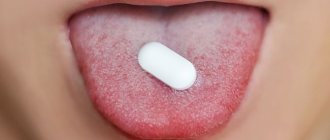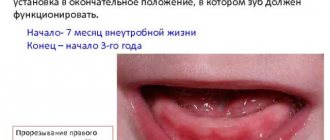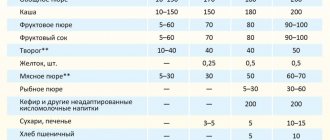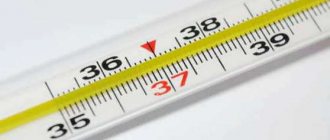At the age of six months, the baby begins to cut his first baby teeth. This is both a joy and a very problematic period.
The process of teething in a child takes about two years. So, for all 2 years, the baby and his family have to worry about the pain that accompanies teething? Not at all! Today there are a lot of methods and drugs that act as pain relievers during teething.
There are children who easily endure various age-related physiological processes, including the appearance of their first teeth. But, as a rule, most children react to such changes quite sharply - they lose sleep, lose appetite, become mischievous, and show their poor health in other ways. How can we help them?
Symptoms of the onset of baby teeth
First of all, parents need to be able to recognize when the teething process has begun. The appearance of the first teeth has the following symptoms:
- inflammation and redness of the gums;
- increased salivation;
- change in the child’s appetite (the baby may refuse food altogether or, conversely, try to eat inedible);
- biting and attempts to gnaw everything on the part of the child (due to the fact that the gums itch during teething);
- not a significant increase in body temperature for a period of 1-2 days (due to the fact that an increased amount of biologically active substances is released in the body);
- slight (up to 3 days, with a frequency of up to 3 times a day) diarrhea, due to the fact that salivation increases and a lot of saliva enters the child’s gastrointestinal tract;
- mild runny nose (clear nasal discharge for about 4 days);
- wet cough (also due to increased salivation);
- lack of sleep (due to discomfort).
What problems can arise during teething?
- Teeth cutting too late. A period of more than 2 months from the moment when they should have started to erupt is considered late.
- Teeth are cutting too early. Although there are cases when a child is born with teeth already erupted. But still, if teeth begin to appear for the most part too early, this is a cause for concern.
- The appearance of teeth outside the dentition.
- Incorrect formation of newly erupted teeth.
- Violation of the order of eruption of the incisors or the absence of one of the teeth.
If symptoms (fever or runny nose) last longer than a couple of days, the child should be seen by a doctor immediately!
How to choose a teething remedy
The eruption of baby teeth is a physiological process that usually begins around 4-6 months of a child’s life and ends at about two and a half years. Regularly occurring symptoms of teething: restlessness (especially at night), increased salivation, itching, swelling and soreness of the gums. Any mother, naturally, wants to make this period of development easier for the child, relieve pain in the gums, and reduce the likelihood of sleepless nights. Therefore, mothers very often ask doctors questions: what to do when teething and how to help the child?
There are several solution options with their advantages and disadvantages:
1. Homeopathic remedies.
On the one hand, ingestion of diluted chamomile and other herbal ingredients will calm the baby, however, from the point of view of scientific medicine, they are unlikely to have any direct effect on the gums.
| 2. Systemic pain relievers (eg paracetamol, ibuprofen) They are safer, but they will also act on the baby’s body in general, and not on the gums. 3. Gels based on lidocaine or benzocaine These are local anesthetics that have an analgesic effect during teething. But there are several nuances: • Firstly, with frequent use, lidocaine and benzocaine can have a toxic effect on the body of a small child. In 2014, the US Food and Drug Administration (FDA) reported 22 cases of severe adverse events to 2% lidocaine gels in children under 3 years of age. Side effects of lidocaine included respiratory distress, decreased heart rate, decreased blood pressure, and convulsions. That is why the Department has imposed a ban on gels with high levels of it. • Secondly, age restrictions: usually from 3 or 6 months. If your baby starts teething early, these medications will not help him. In addition, such gels can have a very specific taste, and the baby may completely refuse to use it again. |
4. Gels based on natural extracts without synthetic anesthetics
These gels are based on extracts that have anti-inflammatory, analgesic and antiseptic effects.
For example, the new Italian gel for gums Dentinale® natura with herbal ingredients: aloe vera juice, boswellia and chamomile extracts, will help postpone the teething period without resorting to analgesics and anesthetics.
Dentinale® natura has a mild anti-inflammatory and antiseptic effect. The gel does not contain :
• synthetic painkillers
• sugar
• parabens
It is almost impossible to overdose on such a drug, it is harmless if swallowed, side effects are not described and theoretically can only be associated with individual intolerance to the components of the gel.
Pleasant to the taste and has no age restrictions.
Easy teething and good nights!
PRODUCTS BY THEME: Dentinale
You can read the reviews at the link: https://www.babyblog.ru/td/itog/41
The order of appearance of baby teeth
The appearance of teeth has a strict sequence, which indicates the correct formation of the masticatory apparatus:
- At the age of 9-10 months, the first lower and upper incisors appear.
- Up to a year (up to 12 months), the second upper and lower incisors erupt.
- The first upper and lower chewing teeth will appear at the age of 12-19 months.
- Fangs erupt between 16 and 22 months of age.
- The child will acquire second upper and lower chewing teeth between 20 and 30 months.
In general, the process of teething is the natural course of things. And it’s definitely not worth accelerating it with mechanical influences. But it is possible to help a child survive it with the least discomfort. The first symptoms of teething may appear a month or two before the actual appearance of the tooth! To prevent a child from feeling discomfort all the time, there are many everyday tricks and even medications designed to relieve pain and inflammation from children’s gums.
“Painkillers” for teething in children: types, methods of use
To facilitate the process of teething, you can use various painkillers, local and general. What types of means are there and are there any restrictions on their use?
To make the process of teething as easy as possible, dentists recommend massaging the child’s gums. The gums are massaged for 1-2 minutes with gentle circular movements with clean hands, while the fingers are wrapped in a sterile napkin. In this case, Asepta napkins, made in the form of a fingertip, have proven themselves to be excellent. Extracts of chamomile and witch hazel in the impregnation have a soothing and anti-inflammatory effect on inflamed gums, reducing pain and swelling.
In addition, it is important to constantly wipe your baby's drool if it drips onto the chin to avoid irritation or rash there. Teething is accompanied by copious salivation; during this period the child must be carefully monitored.
It is necessary to constantly maintain contact with the baby, take him in your arms often and try to distract him with some activities. It is recommended to talk a lot with the child in order to “drown out” his pain.
During teething, you can offer your baby special teethers - toys of various ring-shaped shapes rubberized or filled with cooling thermogel. Before giving such a thing to your child, experts recommend cooling it a little in the refrigerator. But not too much, since the child will refuse very cold toys, and if he does not refuse, he may catch a cold due to contact with a surface with a low temperature.
If the baby refuses special devices for teething and prefers to chew something chosen independently, there is no need to prevent this. However, it should be borne in mind that the object that the child puts into his mouth must be:
- is devoid of sharp protruding parts so that the baby does not cut himself;
- without small parts that a child can “gnaw off” and swallow/chokes on;
- consist of a substance that will not harm the child upon contact.
Many children love to chew on bread crusts or bagels while teething. This is a rather dangerous activity, since the child may choke on crumbs or damage the delicate oral cavity with them.
How to help your baby teething
As an advertisement
Teething is an integral part of childhood and an important stage in a child’s development. For parents, this is new joy and new stress. Unfortunately, not all children tolerate the process of the appearance of their first teeth easily, and most parents remember this period as a series of sleepless nights. The child becomes restless, cries, sleep is disturbed, salivation increases, and the gums become swollen and red. Sometimes body temperature rises, appetite decreases and digestion is disrupted. The baby tries to put everything that comes to hand into his mouth.
On average, children erupt one new tooth every month, from 6 months of age until approximately 3 years of age, until they have a total of 20 baby teeth. The timing and order of teeth appearance may vary for each child.
Gum massage will help ease your baby's condition.
Massage can be performed either with your finger or with the help of special soft brushes and teethers. Chill the teether in the refrigerator for a short time, making sure it is cool and not cold like an ice cube. If the object is too cold, it can harm your gums and your baby. To facilitate teething, you should not give your child dry goods, bagels, a piece of apple or carrot, as crumbs can get into the respiratory tract.
Massage helps improve local microcirculation and additional anti-inflammatory effects, and coolness soothes the gums, dulling the sensitivity of the nerves that transmit pain, and gives relief to the child for a while. When massaging, you can use special dental gels for the gums.
How to choose a teething gel?
It is better to give preference to safer products based on natural ingredients. Avoid using topical anesthetics containing lidocaine as they should only be used as directed and under the supervision of a physician. Gel for gum massage “ Pansoral first teeth”
will help the child endure a difficult period easier. “Pansoral first teeth” is produced in France based on natural extracts of marshmallow, Roman chamomile and saffron. These medicinal herbs are known for their anti-inflammatory, antiseptic, soothing and softening effects. “Pansoral first teeth” is designed specifically for babies. The gel does not contain sugar, ethanol, or synthetic painkillers such as lidocaine or choline salicylate.
Recommendations for use of Pansoral first teeth
Wash your hands thoroughly and apply a small pea-sized amount of gel to your fingertip. Gently massage the gel onto your gums. "Pansoral first teeth" can be used as needed throughout the entire period of teething.
Pierre Fabre LLC 119435, Moscow, Savvinskaya embankment, 15. Tel., fax. www.pierre-fabre-russia.ru
IS NOT
MEDICINE.
Before use, consult a specialist.
Products by topic: [product](Pansoral)
Eruption of molars
When should I expect my molars to erupt? The replacement of baby teeth begins at the age of five and continues until the age of fourteen. By the time the shift is completed, the child will have erupted all 24 teeth, except the wisdom teeth. This is a separate topic for study that parents can refer to later.
The first to change are the incisors on the lower jaw. Then the “sixes” are cut, and only after that the molar upper central incisors grow. By the age of 8, the upper lateral incisors erupt. After this, at 9–10 years old, the upper and lower “fours” change. At 10–11 years old, “fives” change, at 12–13 years old, fangs, and at 14–15 years old “sevens” erupt.
When talking about molars in children, you need to understand that these teeth will remain for life. That is why it is necessary to create favorable conditions for the formation of a new dentition. This is done by taking care of baby teeth and monitoring the eruption of each new molar.
Timely correction of curvature, mineralization, treatment of caries, sealing of fissures - procedures thanks to which the child does not have to hide his teeth while smiling and wear braces for several years.
Remember: each period of teeth change is characterized by its own characteristics and sensations. For example, before this process begins, the child may experience discomfort and pain due to jaw growth. Another example is the eruption of “sixes”, which grow by the age of 6 and are immediately indigenous. Parents should be aware of this so as not to mistake these teeth for baby teeth.
The process of formation of molars will take place without pain and problems if the child is regularly examined by a dentist. It will correct imperfections in time and help teeth grow straight, strong and beautiful.
How teeth are cut
Teething is a complex process, because at this time tissues are formed, tooth roots grow, and gums are rebuilt. Moreover, teeth begin to form during pregnancy, starting from the 6th week. Around this time, calcium begins to be deposited in the tissues of future teeth.
Next comes the fun part – teething. It is considered normal if teeth begin to cut between 4 and 7 months. But every body is unique, so everyone cuts their teeth differently. It depends on many things, for example:
- From genetics. Often the age at which a child begins to cut teeth depends on when his relatives - mom, dad, grandparents - started cutting teeth.
- From nutrition. If your baby doesn't have enough vitamins and minerals, such as vitamin C or calcium, his teeth will start cutting later.
- From the course of pregnancy. If there was fetal toxicosis during pregnancy, this will also slow down the appearance of teeth.
And normally, teeth are cut in pairs, that is, the lower central incisors appear first, then the upper central incisors, the upper lateral incisors - the lower lateral incisors, the upper first molars - the lower first molars, etc. But even if the order is disrupted, this does not always mean any illness or serious violation.
Why does the child have a fever?
When teeth begin to cut, the child may develop a fever, which is completely normal in such a situation. What should parents do to help their baby?
- If the temperature does not exceed 38 degrees, try not to bring it down with medications; just don’t insulate or overheat the baby.
- The baby in this state is very nervous, contact with mommy is very important, so do not deny him the breast, even if it is out of your usual latching regime.
- Let your child drink water more often, because at high temperatures, dehydration occurs faster in the child’s body.
- To make the baby's teething process smoother, you need to lubricate his gums with special gels, for example Kalgel or Cholisal. After this, offer your baby a teething toy. This toy massages the gums well and distracts the baby.
- Gum massage is a very effective remedy; to do this, you need to sit the baby on your lap or simply take a position that is comfortable for both of you, and very carefully massage the gums, without pressing hard and without sudden movements.
- Try to calm the baby down, hug him, rock him, because when a baby cries, as a rule, the temperature begins to rise faster.
- If you periodically wipe the baby's body with warm water at high temperatures, paying special attention to the folds under the arms and between the legs.
Make an appointment










